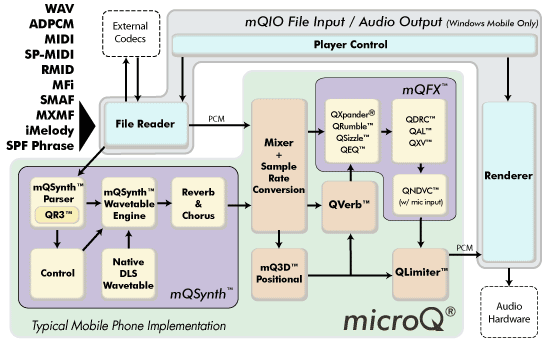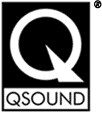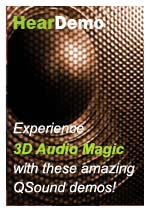 portable digital audio engine
The microQ® JSR234
Competitive Edge
portable digital audio engine
The microQ® JSR234
Competitive Edge- Full JSR234 compatibility:
- Mandated and optional
requirements
- Full support for JSR135
synth controls - Proven track record and
established brand recognition - Replaces dedicated hardware
music synthesizer - Single-vendor audio solution:
- Simplifies integration
- Saves platform resources - Selectable, scalable modular
components for easy implementation - Small memory footprint
- High efficiency processing
- Supports earphones and speakers
- Tunable 3D for all narrow geometry speaker configurations
microQ® for JSR234
for Mobile Devices and Media Players

microQ is QSound Labs' leading-edge digital audio engine enabling polyphonic ringtones, 3D game sound, and enhanced music playback with multiple effects for mobile devices.
microQ for JSR234 is a fully compatible native implementation that supports the special audio processing requirements specified in JSR234 for mobile devices. Java Specification Request JSR234 was established to introduce enablers and controls for advanced multimedia features and capabilities.
microQ represents the culmination of over fifteen years of PC host and DSP audio software development and product deployment by QSound Labs, Inc., a world leader in sonic innovation.
Product Suite
Unmatched by any single vendor, microQ’s modular audio suite consists of the following major components:
mQSynth™ Polyphonic Wavetable Synthesizer
For ringtones and background music in interactive applications such as games, mQSynth plays musical scores contained in performance files (MIDI and similar formats) using digital sample-based instruments.
mQ3D™ Positional 3D Audio Engine
mQ3D Positional places multiple sounds independently in 3D space for interactive gaming. Applicable to arbitrary streams or mQSynth synthesizer channels using native or custom instruments and sound effects. Optional: QEM® environmental modeling (reverberation).
mQFX™ Digital Effects
Enhancing the music listening experience, the mQFX suite of digital effects for JSR234 includes:
- QXpander® 3D stereo sound stage expansion.
- QSizzle™ dynamic high-frequency enhancement.
- QRumble™ dynamic low-frequency enhancement.
- QEQualizer™ fully parametric spectrum control with presets.
- QXtremeVolume™ handset speaker volume maximizer.
- QChorus™ effect of multiple instances of a sound source.
- QAutoLeveler™ automatic gain control.
- QNDVC™ noise dependent volume control.
- QDRC™ dynamic range control.
- QLimiter™ anti-saturation dynamic range control.
- QVerb™ digital reverberation.
mQFX is also available as a separate package. For more details see mQFX page.

microQ Compliance with JSR234
Audio Classes Supported by microQ
| JSR-234 Interfaces and Classes | microQ JSR234 Support |
| AudioFormatControl | yes |
| AudioVirtualizerControl | yes |
| ChorusControl | yes |
| CommitControl | yes |
| DirectivityControl | yes |
| DistanceAttenuationControl * | yes |
| DopplerControl | yes |
| EffectControl | yes |
| EffectModule | yes |
| EffectOrderControl | yes |
| EqualizerControl ** | yes |
| GlobalManager | yes |
| LocationControl * | yes |
| MIDIChannelControl | yes |
| MacroscopicControl | yes |
| ObstructionControl | yes |
| OrientationControl * | yes |
| PanControl | yes |
| PriorityControl | yes |
| ReverbControl * | yes |
| ReverbSourceControl | yes |
| SoundSource3D | yes |
| Spectator | yes |
* Mandatory for 3D Sound under JSR234
**Mandatory for Music under JSR234
Platforms & Implementations
microQ® for JSR234 is written in highly-optimized C++ with a C interface for the audio features of JSR234. The interface is also provided by abstract C++ classes with callable equivalents. These closely follow the Java versions thereby easing the interface with the native Java interface.
microQ features the combination of small footprint and high efficiency that is the hallmark of QSound audio platforms. Modular, scalable components make microQ readily adaptable to any target environment, with the requirement for platform-specific code reduced to input and output interfaces.
microQ is currently available for DSP and RISC architectures running Linux, Symbian OS® 7.0s+, Nokia® Series 60, and Microsoft® Mobile.
- ARM7™/ARM9™/ARM11™/ARM Cortex™+ Neon™ processor families (Optimized by ARM®)
- CEVA-Teak™ and Teak Lite™ DSP cores
- Qualcomm® MSM 6xxx / MSM 7xxx
- Marvell® PXA300 / PXA310
- Tensilica® HiFi 2 Audio Engine
- AMD Imageon™
- Infineon MP-E
- TI® OMAP
microQ can be implemented at various system levels, e.g. within a driver, as a plug-in, part of the glue layer to a JVM, or as a user application.
microQ can be provided in the form of object code, or custom ported by QSound Labs to suit your specifications.
Support for APIs & Standard Formats
microQ renders polyphonic sequenced content (MIDI, SP-MIDI, MXMF, iMelody, MFi v4.0, SMAF-MA2/MA3/MA5 with LED, Vibration and .SPF Phrases) with its native wavetable synthesizer sample set or using custom downloadable instruments (DLS, DLS 2.0, Mobile DLS).
microQ plays multiple linear and compressed digital audio formats (WAV, PCM, ADPCM, MP3*). *On Marvell parts
microQ API support: JSR-135, JSR-234
Fully Compliant with Java Specification Request (JSR)
microQ is fully compliant with JSR 234 and is TCK approved (Technology Compatibility Kit – the suite of tests used to test compatibility against specific JSRs).
Reference Implementations
microQ has been selected as the reference implementation for JSR 234 for the Sun Java Wireless Toolkit and for the Vodafone VFX platform.

